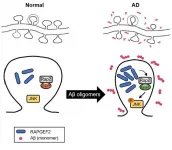(Press-News.org) ITHACA, N.Y. - During mating season, male bearded seals make loud calls to attract a mate. How loud? Well, even their "quiet" call can still be as ear-rattling as a chainsaw.
These elaborate vocalizations are essential for bearded seal reproduction, and have to be loud enough to be heard over the cacophony of their equally loud brethren.
But in the rapidly changing Arctic soundscape, where noise from industrial activities is predicted to dramatically increase in the next 15 years, bearded seals may need to adjust their calling behavior if they are going to be heard above the noise generated by ships and commercial activities.
The bearded seals, however, can only do so much. A study conducted by the Cornell Lab of Ornithology's Center for Conservation Bioacoustics (CCB) found that when ambient underwater noise gets too loud, the bearded seals are no longer able to compensate in order to be heard.
The results of the study, "Limited Vocal Compensation for Elevated Ambient Noise in Bearded Seals: Implications for an Industrializing Arctic Ocean," published Feb. 24 in Proceedings of the Royal Society: Biological Science.
"We wanted to know whether bearded seals would call louder when their habitat grew noisy from natural sound sources," said CCB postdoctoral researcher Michelle Fournet, who led the study. "The goal was to determine if there was a 'noise threshold' beyond which seals either couldn't or wouldn't call any louder in order to be heard. By identifying this naturally occurring threshold, we can make conservation recommendations about how loud is too loud for human activities."
From spring through early summer, the under-ice habitat near Utqiagvik, Alaska, is flooded with the vocalizations of male bearded seals - a sound that can be best described as "otherworldly."
Fournet and colleagues listened to thousands of recorded bearded seal vocalizations from Arctic Alaska spanning a two-year period. Each call was carefully measured and compared with the concurrent ambient noise conditions. They found bearded seals do call louder as their underwater acoustic habitat gets noisier, but there is an upper limit to this behavior. As expected, when ambient noise gets too high, bearded seals are no longer able to compensate in order to be heard.
As a result, as ambient noise conditions increase, the distance over which individuals can be detected goes down.
"Given that these are reproductive calls, it is likely that the seals are already calling as close to as loudly as possible - the males very much want to be heard by the females," Fournet said. "So it is unsurprising that there is an upper limit. I'm grateful that we have been able to identify that limit so we can make responsible management choices moving forward."
Bearded seals - or ugruk in the Inupiaq language - are highly valued by Alaska Native communities in the high Arctic. Since bearded seals are at the center of subsistence and cultural activities in Inupiaq communities, threats to them threaten the communities that rely on them.
"This work never would have happened without the insight and guidance of Arctic communities," Fournet said. "It was their energy that led the Cornell Lab to place hydrophones in the water. It is our job to continue listening."
INFORMATION:
The study was co-authored with Christopher Clark, visiting senior scientist at CCB; Holger Clink, director of CCB and assistant professor at the Department of Fisheries and Wildlife, Oregon State University; Aaron Rice, CCB principal ecologist; and Margherita Silvestri of the Marine Ecology Lab, Sapienza University of Rome.
Washington, DC - February 24, 2021 - In the absence of effective treatments for COVID-19, many countries have approved the therapeutic use of blood plasma from recovering patients because it contains antibodies against the coronavirus. But not every type of antibody can neutralize the virus and render it noninfectious. New research published this week in mSphere, an open-access journal of the American Society for Microbiology, explores variation in virus neutralization capabilities, which can vary widely by type of antibody.
"What we need for plasma therapy is not only high levels of antibodies but also high neutralization capability," said virologist Michael Schindler, Ph.D, at University Hospital Tübingen, ...
X-rays are used to study the atomic and microstructure properties of matter. Such studies are conducted with special accelerator complexes called synchrotrons. A synchrotron source generates powerful electromagnetic radiation with a wavelength equal to fractions of a nanometer. Some X-rays are reflected from the atomic planes of a crystal and some go through the crystal plane that plays the role of a beam-splitter (or the so-called semitransparent mirror). If the radiation passes through monochromators-optical devices that consist of two or more ideal crystals - its optimal exit wavelength can be regulated. ...
Researchers have developed a data transfer system that can transmit information 10 times faster than a USB. The new link pairs high-frequency silicon chips with a polymer cable as thin a strand of hair. The system may one day boost energy efficiency in data centers and lighten the loads of electronics-rich spacecraft.
The research was presented at this month's IEEE International Solid-State Circuits Conference. The lead author is Jack Holloway '03, MNG '04, who completed his PhD in MIT's Department of Electrical Engineering and Computer Science (EECS) last fall and currently works for Raytheon. Co-authors include Ruonan Han, associate professor and Holloway's PhD adviser in EECS, and Georgios Dogiamis, ...
Korea Brain Research Institute (KBRI, Pann-Ghill Suh (President)) announced that Dr. Kea Joo Lee and Dr. You-Na Jang of the Neural Circuits Research Group have identified the mechanism causing synaptic loss in Alzheimer's disease as the aberrant expression of RAPGEF2, a synaptic protein.
- The results were published on January 2021, in the online Early View of Neuropathology and Applied Neurobiology.
* (Title) RAPGEF2 mediates oligomeric Aβ-induced synaptic loss and cognitive dysfunction in the 3xTg-AD mouse model of Alzheimer's disease
Alzheimer's disease (AD) accounts for about 75% of dementia cases and is the most common type of degenerative brain disease. AD is a devastating because disease progression can cause ...
Chemical & Engineering News (C&EN), the newsmagazine of the American Chemical Society (ACS), is celebrating Black chemists and chemical engineers with a special issue highlighting Black chemists who work across the fields of biotechnology, solar energy, pharmaceuticals and more. Guest edited by Massachusetts Institute of Technology (MIT) drug delivery pioneer Paula Hammond, Ph.D., this special issue showcases Black scientists, spotlighting their scientific passions and career accomplishments.
"In bringing into focus the unique lives of this set of accomplished Black scientists in chemistry and chemical engineering, ...
The steadily increasing prevalence and high costs of treating chronic joint pain worldwide poses a challenge for healthcare systems and healthcare payers. New research published today in END ...
The family of ENDOU enzymes is found in most organisms, yet its functions are only poorly understood. In humans, it has been connected with cancer. RNA viruses, such as SARS-CoV2, contain a gene corresponding to ENDOU, and this is important for virus replication and the suppression of the immune response. However, so far only few details of the role of these enzymes are known. The research group led by the molecular geneticist Dr. Wenjing Qi from the University of Freiburg now contributes some more details to its function in a study published by the renowned scientific journal Nature Communications. They suggest that the gene ENDU-2 could ...
Responding to artificial intelligence's exploding demands on computer networks, Princeton University researchers in recent years have radically increased the speed and slashed the energy use of specialized AI systems. Now, the researchers have moved their innovation closer to widespread use by creating co-designed hardware and software that will allow designers to blend these new types of systems into their applications.
"Software is a critical part of enabling new hardware," said Naveen Verma, a professor of electrical and computer engineering at Princeton and a leader of the research team. "The ...
More U.S. adults reported receiving or planning to receive an influenza vaccination during the 2020-2021 flu season than ever before, according to findings from a national survey.
The survey of 1,027 adults, conducted by the University of Georgia, found that 43.5% of respondents reported having already received a flu vaccination with an additional 13.5% stating they "definitely will get one" and 9.3% stating they "probably will get one." Combined, 66.3% have received or intend to receive an influenza vaccination.
By comparison, 48.4% of adults 18 and older received the vaccine during the 2019-2020 flu season, according to the Centers for Disease ...
A new analysis of education debates on both social media and in traditional media outlets suggests that the education sector is being increasingly influenced by populism and the wider social media 'culture wars'.
The study also suggests that the type of populism in question is not quite the same as that used to explain large-scale political events, such as the UK's 'Brexit' from the European Union, or Donald Trump's recent presidency in the United States.
Instead, the researchers - from the University of Cambridge, UK, and Queensland University of Technology, Australia - identify a phenomenon called 'micropopulism': a localised populism which spotlights an aspect of public ...



